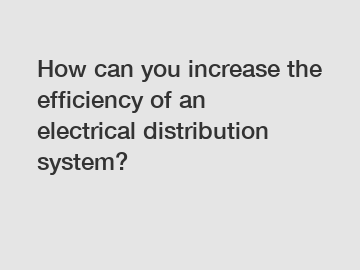How can you increase the efficiency of an electrical distribution system?
How can you increase the efficiency of an electrical distribution system?
In today's rapidly evolving world, the demand for electricity continues to rise. As a result, it has become increasingly important to ensure the efficiency of electrical distribution systems. An efficient electrical distribution system not only helps in minimizing energy loss but also promotes cost-effectiveness and sustainability. So, how can you increase the efficiency of an electrical distribution system? Let's explore some key points:
1. Upgrading and Modernizing Equipment:

One of the primary steps towards enhancing the efficiency of an electrical distribution system is by upgrading and modernizing the equipment. Outdated transformers, switches, and cables can significantly contribute to energy loss. By replacing these components with newer and more efficient alternatives, such as smart transformers and high-performance cables, the system's efficiency can be greatly improved. These advancements reduce energy loss and ensure a more reliable distribution of electricity.
2. Implementing Power Factor Correction:
Power factor is an important factor in the efficiency of electrical distribution systems. Low power factor can result in increased energy consumption and higher operating costs. By implementing power factor correction techniques, such as capacitor banks, it is possible to optimize the power factor and improve system efficiency. These techniques help in reducing reactive power, thereby minimizing power loss and avoiding penalties imposed by utilities for poor power factor.
3. Conducting Regular Maintenance and Inspections:
Regular maintenance and inspections are crucial for the efficient functioning of an electrical distribution system. Loose connections, faulty components, and damaged cables can lead to energy loss and potential safety hazards. By conducting routine inspections and promptly addressing any issues, the system's overall efficiency can be significantly improved. Regular maintenance also involves cleaning and testing of equipment, ensuring optimal performance and reducing energy wastage.
4. Implementing Energy Management Systems:
Energy management systems (EMS) offer a comprehensive approach to improving the efficiency of electrical distribution systems. These systems monitor and analyze energy consumption patterns, allowing for better control and optimization. By integrating advanced metering infrastructure and intelligent control algorithms, EMS can identify areas of energy wastage and enable real-time adjustments to enhance overall system efficiency. The data provided by these systems also aids in identifying opportunities for load balancing and energy-saving measures.
5. Embracing Renewable Energy Integration:
Increasing the utilization of renewable energy sources is another way to enhance the efficiency of electrical distribution systems. Renewable energy, such as solar and wind, can be integrated into the grid to reduce dependence on traditional fossil fuel-based power sources. Efficient integration and management of renewable energy can help in balancing loads, reducing transmission losses, and achieving a greener and more sustainable electrical distribution system.
6. Implementing Demand Response Programs:
Demand response programs involve incentivizing consumers to adjust their electricity usage based on real-time demand conditions. By participating in such programs, consumers can contribute to load management and peak shaving. This helps in reducing strain on the electrical distribution system during periods of high demand, ultimately increasing its efficiency. Demand response programs also provide financial benefits to consumers, encouraging them to adopt energy-efficient practices.
7. Investing in Smart Grid Technologies:
The deployment of smart grid technologies plays a pivotal role in enhancing the efficiency of electrical distribution systems. Smart meters, advanced monitoring systems, and grid automation enable better communication, improved reliability, and efficient load management. These technologies provide real-time data, enabling utilities to identify inefficiencies, optimize energy distribution, and reduce energy losses. Smart grid technologies also allow for the integration of renewable energy sources and facilitate advanced monitoring and control of the distribution system.
In conclusion, increasing the efficiency of an electrical distribution system is crucial for meeting the rising energy demands sustainably. Upgrading equipment, implementing power factor correction, conducting regular maintenance, and embracing renewable energy integration are effective ways to improve system efficiency. Additionally, implementing energy management systems, demand response programs, and investing in smart grid technologies offer comprehensive approaches to achieving a highly efficient electrical distribution system. By undertaking these initiatives, we can ensure optimal energy utilization, reduce environmental impact, and pave the way for a brighter and more sustainable future.
Are you interested in learning more about lightning arrester wholesale, vacuum circuit breaker parts, power plant low-voltage power distribution cabinet? Contact us today to secure an expert consultation!

Comments